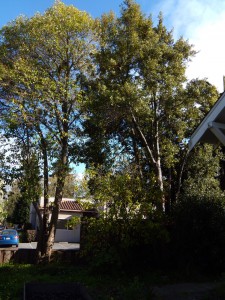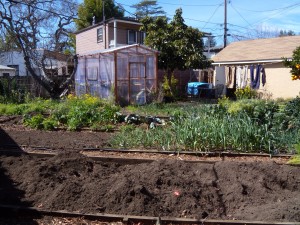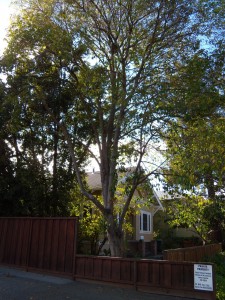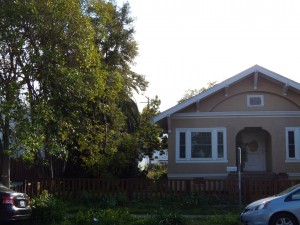I’ve never been much good at sharing, but Kelly and I recently decided to welcome a garden sub-letter of sorts to our little farmstead. Matt, our back-fence-neighbor, was on the hunt for gardening space. Specifically, he is eager to grow hops, kale, scarlet runner beans, and tea. How could we not get excited?
In exchange for dirt, sunshine, water, and a corner of the greenhouse, Matt has agreed to put in five hours a month helping out with garden projects (translation: weeding Bermuda grass). We are thrilled to have him around. Since we are reclusive, uptight types, we have created an elaborate schedule for Matt’s gardening forays which takes into account his night shifts and our lazy mornings in pajamas. We trust it will all work out, and we are eternally grateful to him for putting up with our chickens’ egg-laying squawks during his sleeping hours. Matt, if you’re reading this, we are sooo appreciative of your flexibility and good humor.
The process of deciding to share our garden with another human has been an interesting one. We’ve considered the idea before and always shied away. Gardening is intimate and personal. The garden is where we meditate–unofficially, while pulling weeds—and where we find artistic expression. It offers comfort and solitude and the opportunity to connect with the natural world and to actively participate in it.
But gardening is also about community. It is an acknowledgment of our human needs for nourishment and our age-old connection with the landscapes we each call home, and with each other. We have a big garden (at least for two city dwellers) and Matt lives in an apartment with one north-facing balcony overlooking our chicken coop. The match seems preordained. Add to that that Matt is uncommonly polite, sensitive to our slightest prickle, and genuinely enthused at the prospect of training hops up onto his balcony railing.
Of course, we have always shared our garden. With the squirrels and raccoons. With the titmice and towhees. With the crimson throated hummingbirds and carpenter bees. Sometimes, in our quest to conquer weeds and tame shrubs, we forget these other residents. I have a thing for growing food and a tendency to turn up my nose at Kelly’s ornamentals and California natives.
Had I been born a few hundred years earlier and made the trek west across the United States, I strongly suspect that I would have worked with dedication to eradicate any native fauna that dared to compete for my crops or game and would have steadfastly worked to clear land of offending native flora. I’m not proud of this, I guess. It’s just that, on some level, I want so badly to survive that it seems like a crime not to utilize every inch of the garden for human life sustaining crops.
Which leads me to our latest dilemma. We’ve been lobbying the landlord for years to remove several weed trees in the front yard to allow us more room and light to plant interesting things. Now, suddenly, the gears are in motion and removal is set to start on April 2nd. Kelly came to me forlornly the other day and asked about the towhees. Don’t they love that spot in amongst the sick laurel’s suckers? Isn’t it shady and cool for them in summer? Might they nest there, hidden where we’ve never seen?

The two trees in question: privet on the left and laurel on the right. Apologies for the dark picture, but that’s kind of the point.
We sat in the front yard for a long time and watched the sun move behind the laurel, the front yard destined to shadiness for the remainder of the day. I waded into the suckers and tried to really imagine the front yard without this towering tree. And of course, I felt guilty. We’re not the only ones counting on this garden for sustenance—in fact, we have far more options than our non-human neighbors.
Where will the towhees go if the tree comes down? Will the garden start to look like someone else’s? For all my efforts to mulch the weeds into nonexistence, I’ve realized in the past few days that my image of the garden includes large swaths of unruly weeds. I’ve never been intimately involved with an immaculate, well-kept garden—and maybe I don’t want to be.
Anything we plant in the space the laurel and privet now inhabit would ultimately provide habitat. We’ve talked about pomegranate and currants, lavender, artichokes, and redbuds. But the fact remains that wiping the slate clean will change our garden landscape and impact the lives of countless local critters on every scale. How does one make a choice like that once one has become utterly bogged down with the inherent ethical questions? What, exactly, is a gardener’s place?





7 Responses to Sharing the Garden